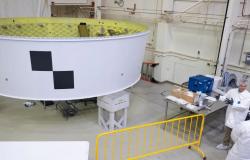Busy days are coming up on the agenda public transport from the city of Córdoba. As announced by the Secretary of Government of the Municipality, Rodrigo Fernández, in the coming days the draft ordinance of the new regulatory framework will reach the Deliberative Council, which is the legal structure on which the bidding for the new system must be mounted.
As he was able to find out The voiceit is a regulatory framework that is proposed as “flexible”, which will allow lines and routes to be adapted according to the evolution and changes in demand in the next decade.
In addition, it will take into account the recommendations made by the demand study financed by the European Union, so it will have a metropolitan character. For this reason, the role of the Intermunicipal Metropolitan Management Entity will gain importance, since it will be in charge of carrying out the new tender.
In the 6 de Julio Palace they consider that this instrument, created by the current governor Martín Llaryora when he was mayor of the capital, has sufficient legal capabilities to set up a mobility scheme that exceeds the limits of the city of Córdoba, but without the interference of the Provincial Transportation Secretariat.
The regulatory framework will allow those localities in Greater Córdoba to make agreements with the Capital to integrate them into the tender and for the lines to reach there. In addition, the Entity will have a transportation executing unit that will be responsible for launching the system.
Tamse SA
Another novelty that the administration of Mayor Daniel Passerini has in the pipeline is the transformation of the municipal company Tamse into a public limited company.
This occurs due to the effects of the famous DNU of the president, Javier Milei. In the section referring to State reforms, article 36, he says: “Decree-law No. 15,349/46 is repealed.”
The decree-law to which it refers has been in force since 1946, when it was incorporated as a special title in the Commercial Code. This decree enabled national, provincial and municipal states, or autonomous administrative entities, to associate with private capital “for the exploitation of companies whose purpose is to satisfy collective needs or the implementation, promotion or development of activities.” economic”.
Milei’s DNU, in its Chapter II, emphasizes that State companies must be transformed into public limited companies. In its article 48 it says: “Companies or companies with participation of the State, whatever the type or corporate form adopted, will be transformed into Public Limited Companies.”
Thus, Municipal Automotive Transport Sociedad del Estado (Tamse) will be renamed Municipal Automotive Transport Sociedad Anónima (Tamsa), whose shareholding composition will be majority of the Municipality of Córdoba, but the intention is for the participating cities and towns to join as shareholders. to the Entity.
The objective is for the new Tamsa to have a leading role in the new metropolitan system, not only providing service in the Capital but also offering public transportation in municipalities that want to create their own system.
Bye flat rate and new ticket calculation
Although the content of the project for the new transportation regulatory framework was not disclosed, the municipal Executive allowed some aspects to emerge. For example, the rate, which will no longer be flat. Today, you pay the same ticket regardless of the distance traveled.
It is different, for example, in the city of Buenos Aires where the price varies as the distances are greater.
In reality, it would be returning to the old section scheme that governed the transportation system that was implemented in 1987 during the mayorship of Ramón Bautista Mestre and that had two sections. The first was for trips within the Ring Road, and the second for those starting outside.
That model was later abandoned, and the second section was only left for trips on the 500 and 600 ring lines.
Now, what is proposed is a rate up to eight kilometers, and from there a more expensive price. However, the possibility of combining different lines to complete trips will be maintained, as it currently works.
Those who know the system argue that in the flat rate, users who make shorter trips subsidize those who make longer trips.
Another novelty regarding the ticket is that the new regulatory framework will simplify the formula to calculate the fare to the extreme. Three economic variables will be taken into account: the cost of fuel, the salary cost and the inflation index. When any of them exceed a certain index, the update of the trip price is enabled.
What will the new mobility system be like?
The Municipality assures that the new scheme is designed according to the recommendations of the Sustainable Urban Mobility Plan, which was presented last December in Plaza España. The plan was financed by the European Union through the Euroclima + initiative, and managed by the French Development Agency (AFD).
The structure of the plan is organized into trunk lines, main lines, proximity lines, metropolitan lines, specific services for people with disabilities, as well as a cycling and pedestrian network.
Trunk lines, operated by articulated buses, must be highlighted for their high capacity and frequency and must connect the main nodes in highly competitive travel times, with a frequency of less than 5 minutes.
In turn, the main lines, which include urban buses and trolleybuses, act as feeders of the trunk axes, irrigating the territory for trips on an urban and metropolitan scale, with a frequency of 8 to 12 minutes.
Then comes neighborhood-scale connectivity. Proximity lines, composed of urban buses and minibuses, operate at low frequency and connect the trunk and main lines to the different flow generators within a neighborhood, ensuring internal connectivity on a neighborhood scale, with a frequency of at least 15 minutes. .
In addition, the metropolitan lines, represented by interurban buses, circulate through the territory of Córdoba, harmonized with the structure of the metropolitan network and ensuring connectivity between urban poles. Some express lines have 20-minute frequencies, while others operate every 30 or 45 minutes.
They will buy 20 CNG buses from Iveco to reinforce the trolleybuses
The Municipality of Córdoba will purchase 20 zero-kilometer buses manufactured by Iveco, in the southeastern area of the city, with a Bancor loan.
They have the particularity that they are not diesel but use compressed natural gas (CNG) as fuel. They will provide service on Tamse’s “green lines”: these are the routes covered by trolleybuses, which run on electric power.
The 20 new units are expected to be ready in the first days of July. Daniel Passerini’s administration wants to reinforce the provision of lines A, B and C, which have high user acceptance but have not received new units for seven years, when seven Russian trolleybuses arrived.
Iveco manufactures the chassis at the Ferreyra neighborhood plant. They weigh 17 tons and the development of the use of CNG was carried out by Iveco Córdoba engineers.
It is an engine that uses exclusively CNG, it is not a hybrid with gasoline. It is the same one that equips the Téctor trucks. The chassis is equipped with nine 80-liter tubes, which gives it a range of 300 kilometers.
The charging time is less than 30 minutes, and Tamse will adapt its own service station with fast charging peaks to supply these units.
When will the ticket increase
In the Municipality of Córdoba they insist that they will not increase the price of the urban transport ticket until more zero kilometer units arrive.
That will begin to happen around June 20, when Coniferal finishes incorporating its first 100 new Mercedes Benz buses and completes the transfer of the remaining lines of corridor 4. By that date, Tamse expects to receive another 50 new Mercedes Benz cars , to add them to runners 2 and 5.
Only after that date will the ticket price be updated, which will cost $940.
When does the Sube arrive?
On the other hand, the Municipality is hopeful that the Sube will be implemented in Córdoba. But it will have a peculiarity: it will coexist with other means of payment, such as the Bus Network. That is, only the beneficiaries of social attributes (ATS) will have it, and the Nation will be responsible for incorporating the validators so that they can use those cards.
It must be remembered that the Sube has no impact on what users pay. Rather, the municipality and the Province receive compensation for the beneficiaries of the ATS.






